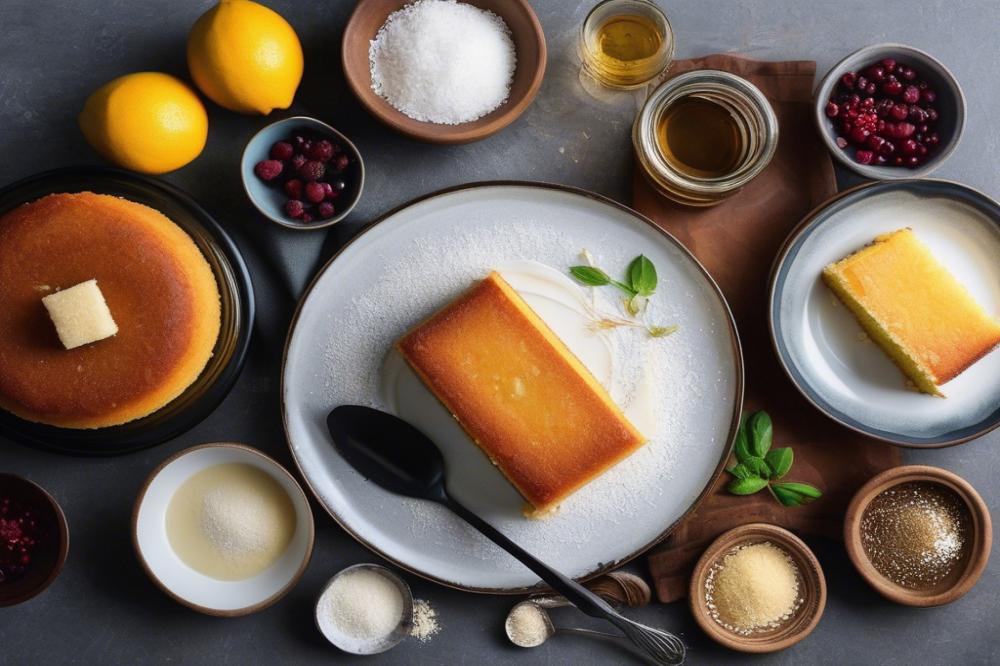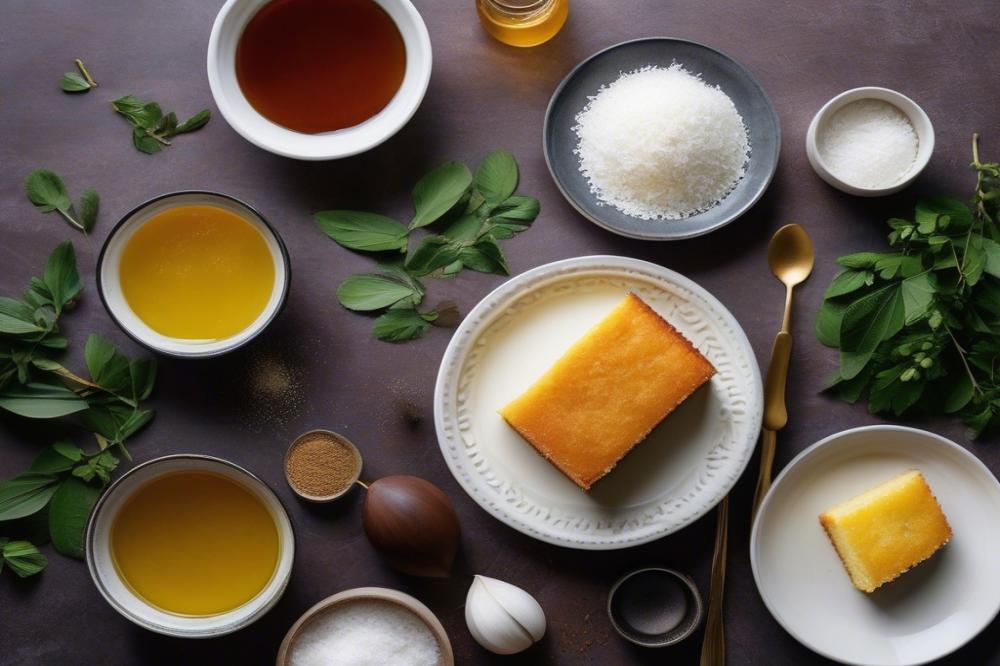Introduction
Ravani stands as a beloved classic in the world of Greek desserts. It represents the rich traditions and culinary flavors that define Mediterranean cuisine. This semolina cake appeals to those who appreciate sweet treats, offering a texture that is both moist and satisfying. Its origins trace back to ancient times, making it a staple in various gatherings and celebrations.
Semolina cakes have long been cherished in many Mediterranean cultures. The hearty grain provides a unique base that holds its shape well during baking. This ingredient is not just functional. It contributes significantly to the cake’s inviting aroma and delightful taste. Families often gather around well-set tables, sharing these simple yet decadent delights during festive occasions or as everyday snacks.
Coconut syrup plays a crucial role in this cake recipe. Adding a layer of sweetness, it heightens the overall flavor profile. This syrup brings a tropical touch to the traditional dessert, transforming it into a Coconut Greek Syrup Cake. The blend of coconut with the classic ingredients creates a harmonious balance. Such adaptations keep dessert-making exciting and relevant in contemporary kitchens while honoring tradition.
What is Ravani?

Ravani is a traditional Greek semolina cake that delights many with its unique texture and flavor. Made primarily from semolina, this sweet treat is often soaked in a luscious syrup after baking. The combination of ingredients makes the cake moist and fragrant, complementing its rich taste.
Throughout history, Ravani has held a significant place in Greek culinary traditions. Often served at celebrations like weddings and religious holidays, this dessert symbolizes joy and festivity. Regional variations exist, reflecting the local ingredients and customs of different areas in Greece. For many, it evokes memories of family gatherings and shared dishes, enhancing its cultural importance.
This dessert can be compared to other popular Greek desserts, such as baklava and karpatzopita. While baklava features layers of phyllo dough and nuts, Ravani takes a simpler, more straightforward approach with its cake base. Each dessert has its own charm and place in Mediterranean cuisine, but the moist cake version of Ravani stands out for its easy dessert recipes appeal. Preparing it requires less skill than some more elaborate options, making it a favorite among home bakers.
The addition of coconut syrup further elevates this cake’s flavor. It adds an exotic twist that complements the semolina base beautifully. When served at parties, this dessert shines on any table, beckoning guests to indulge. Its sweet, syrup-soaked goodness is a perfect choice for those who adore Mediterranean sweets.
Ingredients and Measurements

To create a delicious Greek dessert, you will need a selection of essential ingredients. Here’s what you’ll need for this semolina cake:
- 1 cup semolina
- 1 cup granulated sugar
- 1 cup yogurt
- 4 large eggs
- 1/2 cup vegetable oil
- 1 cup coconut flakes
- 1 tablespoon baking powder
- 1 teaspoon vanilla extract
- 2 cups water (for syrup)
- 1 cup sugar (for syrup)
- 1 cup coconut milk (for syrup)
- Optional: Zest of 1 lemon
Now, let’s analyze the nutritional information for each key ingredient. Semolina is a primary source of carbohydrates and provides energy. Yogurt adds protein and contributes to a moist cake texture. Eggs are crucial for binding and maintaining structure while bringing in additional protein. Granulated sugar sweetens the dessert. Vegetable oil keeps the cake moist, and coconut flakes add flavor and texture. For the syrup, water hydrates, while additional sugar and coconut milk create a luscious topping.
Consider potential ingredient substitutions if dietary needs arise. Instead of granulated sugar, you could use coconut sugar for a unique flavor twist. Non-dairy yogurt serves as a suitable alternative to fit vegan diets. If someone is avoiding eggs, you might substitute with flaxseed meal or a commercially available egg replacer. For the baking powder, a mix of baking soda and lemon juice can be effective in creating lift.
Adapting this traditional recipe to accommodate various preferences is possible. Dairy-free variations can be created by using non-dairy yogurt and coconut milk. Gluten-free devotees could swap semolina with ground almonds or a gluten-free flour mix, though this can change the cake’s texture and density.
This moist cake is not just a simple dessert but a potential highlight for any gathering. Enjoy it at birthday parties or holiday celebrations. Sweet treats like this also bring a touch of Mediterranean cuisine to your dessert table.
Cooking Instructions

Making this Greek dessert may seem daunting at first, but it’s really quite simple. Follow these step-by-step guidelines to create a moist cake that will impress your friends and family.
Preparing the batter
Begin by gathering your ingredients. In one bowl, whisk together the dry ingredients: semolina, flour, baking powder, and a pinch of salt. In a separate bowl, combine the wet ingredients. This includes eggs, yogurt, melted butter, and vanilla extract. Slowly mix the dry ingredients into the wet mixture. Stir until everything is combined well. The batter should be thick but smooth, perfect for a semolina cake.
Baking the semolina cake
Preheat your oven to 350°F (175°C). Grease a baking pan to prevent sticking. Pour the batter into the prepared pan and spread it evenly. Bake the cake for about 30 to 40 minutes. Watch for a golden top and a toothpick inserted into the center to come out clean. Once it’s done, remove it from the oven and let it cool slightly.
Making the coconut syrup
This syrup is what makes the cake special. Start by combining sugar and water in a saucepan over medium heat. Stir until the sugar dissolves completely. Add coconut milk to the mixture for that rich coconut flavor. Allow the mixture to simmer for about 10 minutes, creating a thick syrup. Make sure to stir occasionally. You want the syrup to become slightly sticky.
Soaking the baked cake in syrup
After the cake has cooled for about 10 minutes, it’s time for the soaking. Carefully poke holes in the top with a skewer or fork. Slowly drizzle the coconut syrup over the warm cake. This process allows the syrup to seep into the semolina, enhancing the flavor. Let it soak for at least half an hour so that the syrup is absorbed fully.
Optional serving suggestions
When serving this Mediterranean cuisine delight, consider garnishing it with chopped nuts like pistachios or almonds. Fresh fruits can also be a nice touch. Another idea is to serve it with a side of yogurt. These additions can elevate your sweet treats into something truly delightful, perfect for any party or gathering. Plus, they can add an extra layer of flavor.
Variations of Ravani

Exploring the different regional interpretations of the Greek dessert, you will find a variety of flavors and textures in this beloved semolina cake. In Turkey, for instance, this treat goes by the name “revani” and often incorporates zest from citrus fruits, lending a fresh twist to the moist cake. In many parts of Greece, it is common to serve it with a generous drizzle of coconut syrup, enhancing the dessert’s sweetness and aroma.
Substituting flavors can offer delightful surprises. Adding spices like cinnamon or nutmeg can elevate the rich taste of this traditional recipe. Some bakers choose to fold in fruits such as raisins or nuts into the batter, adding depth and making it even more appealing for sweet treats lovers.
Constructing a unique version of this cake might involve experimenting with different types of syrups as toppings. Traditional rose water syrup is a popular choice and adds a floral note. Alternatively, you could drizzle a light honey syrup infused with vanilla for a comforting flavor profile. Some innovative chefs might even consider using a chocolate syrup to create a fusion dessert that attracts a younger crowd.
Party desserts often feature this semolina cake for its versatility. Easy dessert recipes highlight its adaptability to changing tastes and preferences. This means you can make it just how you like by playing around with the ingredients. Baking remains a joyful activity when you create something that reflects your imagination. Feel free to get creative! Each slice can tell a different story through its unique combination of flavors and textures.
Serving Suggestions and Pairings
Ravani shines at parties and gatherings, making it a prime choice for any celebration. It’s a Greek dessert that appeals to many, thanks to its rich flavor and moist texture. Consider cutting it into squares or triangles to create easy portions. This makes serving simple and encourages guests to indulge in multiple sweet treats.
Another way to delight your guests is by pairing the semolina cake with a hot cup of coffee or tea. The warmth of the beverages contrasts beautifully with the coconut syrup’s sweetness, creating a delightful experience. Imagine sipping coffee while savoring a bite of this traditional recipe. It’s a match that captures the essence of Mediterranean cuisine.
For additional side options, fresh fruits can bring brightness to your dessert table. Slices of juicy oranges or berries provide a refreshing balance to the rich cake. Whipped cream also adds a creamy texture that complements the coconut syrup nicely. Combining these elements can elevate your dessert spread.
Experimenting with toppings can also transform the dish. Nuts, for instance, bring crunch and flavor, enhancing the moist cake. Some might enjoy a drizzle of more coconut syrup atop, making each bite even more decadent. Offering these variations invites guests to personalize their plates.
With easy dessert recipes like this, everyone can find joy in sharing Ravani. Setting it in the center of the table invites conversation and encourages tasting. Add variety with your beverage choices, and your gathering will feel even more festive.
Final Thoughts on Ravani with Coconut Greek Syrup Cake
Making ravani with coconut Greek syrup cake is a delightful experience that blends simple ingredients into a rich, flavorful treat. The process involves mixing semolina with assorted flavors, baking it to perfection, and then soaking it in a sweet syrup. Each step brings a sense of satisfaction, as the enticing aromas fill your kitchen. Once cooled, the texture of the cake paired with the syrup creates a memorable dessert.
This easy-to-follow recipe is perfect for any occasion, whether it’s a family gathering, a holiday celebration, or simply a weekend treat. Each bite invites a taste of tradition that honors Greek culinary heritage while fitting seamlessly into modern dining. Bake it for your loved ones or even for yourself; you deserve a delicious reward after a hard day.
Making traditional Greek desserts like this one helps keep cherished flavors alive. Embracing these baking practices connects us to culture and history. As time goes on, these recipes remind us of their importance in bringing people together. In a world filled with change, enjoying a slice of semolina cake can instill a sense of comfort and belonging.
So, gather your ingredients and try this wonderful dessert. With each step, remember that the best dishes often come from time-honored recipes. You might find that this ravani will become a favorite for many in your life.



